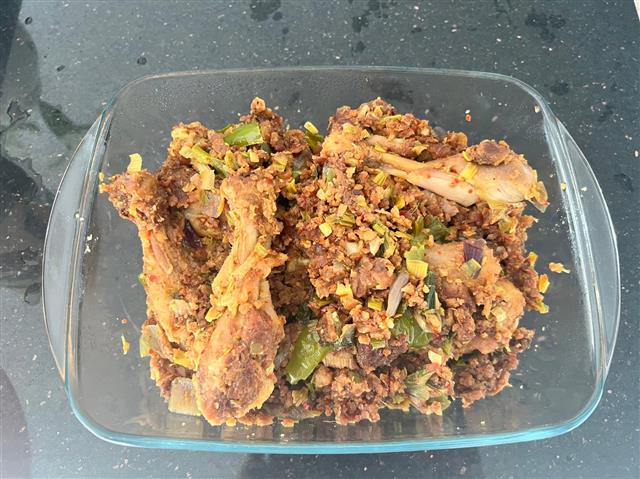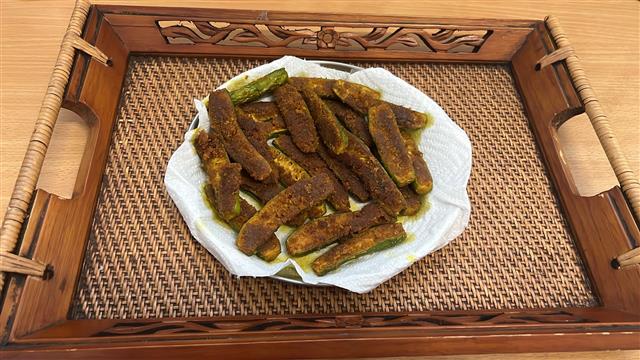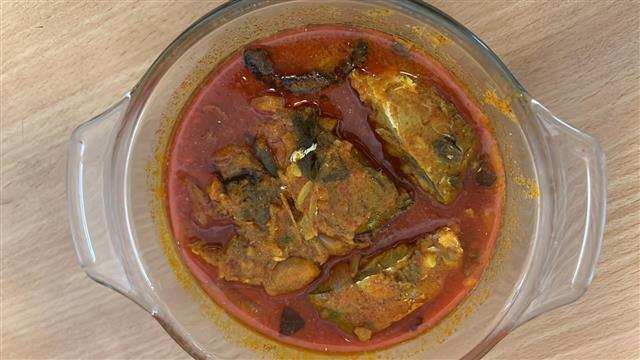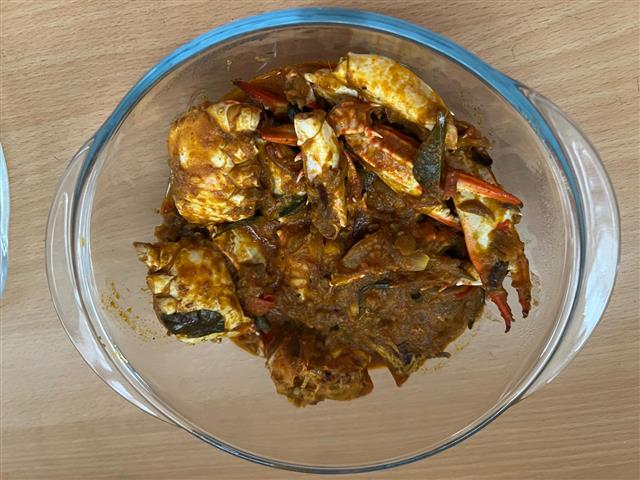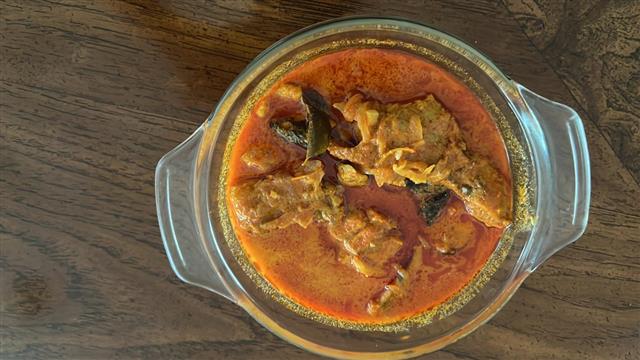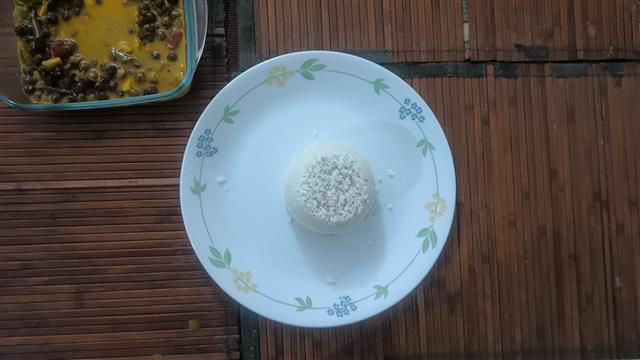
Potato Bhaji
(4 reviews)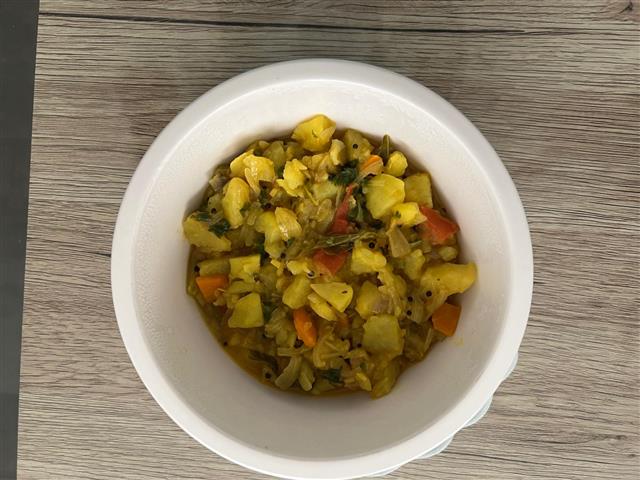
Potato Bhaji is a heartwarming dish that's beloved across Indian households. The Kerala version is a dry curry-style preparation and is usually served alongside poori or dosa, even appam.
The dish features soft, hand-mashed potatoes cooked in a gentle masala of onions, green chilies, and ginger, lightly spiced and often perked up with a few carrot pieces and fresh coriander. It's flavorful but not overwhelming, ideal for both breakfast and dinner.
What makes Kerala-style Potato Bhaji distinct is its subtle blend of tempering ingredients like mustard seeds and a couple of fenugreek seeds, which add a nutty depth to the dish.
Ingredients
Directions
- Cut potatoes cut into 2 pieces and cook in pressure cooker for 2 whistles.
- Peel the skin and keep aside.
- In a pan add mustard seeds, fenugreek seeds, onion, some ginger and green chillies.
- Saute well and add 2-3 pieces of carrot and saute.
- Crush the potatoes by hand into small pieces add to the mixture
- Add salt and water to the and cook well. Add coriander leaves.
Cooking Tips
• Boil the potatoes just right: Two whistles in a pressure cooker is enough. Overcooking will make them too mushy, while undercooked potatoes will remain firm and won't blend well with the masala.
• Hand-breaking versus chopping: Tearing the potatoes by hand helps them absorb flavors better and creates a rustic texture that's key to a good bhaji.
• Go easy on fenugreek: Just 2–3 seeds are enough. Too much can turn the dish bitter.
• Use oil that suits the mood: Coconut oil gives it a distinct Kerala touch, while sunflower or groundnut oil works for a more neutral flavor.
• Don't skip the carrots: They add natural sweetness and a light crunch, and balance the soft texture of potatoes.
How to Serve
• Serve hot with Poori or chapati
• Pair it with dosa or even set dosa for a South Indian hotel-style breakfast.
• Serve as a side dish for appam or rice and sambar (in lunchboxes).
• Serve it Semiya upma or Kesari to create a mixed breakfast platter (For festive breakfasts or special occasions)
The Story Behind Potato Bhaji
What Is Potato Bhaji?
Potato Bhaji is a dry or semi-dry curry made with boiled potatoes and cooked with basic aromatics and spices. This version is milder and often includes a few bits of vegetables like carrots to add color, nutrients, and texture. It's known by different names from Urulakizhangu Bhaji to Poori Bhaji, due to its classic pairing with hot and puffed up pooris.
Our recipe avoids garam masala and opts for minimal flavours. Unlike other Indian styles, which include turmeric, garlic, or a spice-heavy base, this bhaji is light. The focus is on the creamy and earthy potatoes, sweet onions, and the kick of green chilies
In Kerala's semi-urban households, bhaji is both a breakfast dish and an last-minute dinner idea. With potatoes always on hand, it's a dish that needs little planning but gives a whole lot of taste and satisfaction. you can pair it with dosa, puri, chapathi, appam or rice which makes ita must-know recipe.
Ingredient Health Benefits
Potatoes: Potatoes are a great source of complex carbohydrates, potassium, and Vitamin C. When cooked without deep frying, they provide energy and keep you feeling full longer.
Ginger: Known for its anti-inflammatory and digestive properties, ginger not only adds flavor but also helps soothe the stomach—especially beneficial when having this dish with heavier foods like puri.
Fenugreek Seeds (Uluva): Just a couple of seeds go a long way in aiding digestion and reducing bloating. In Ayurvedic practice, fenugreek is often used to balance internal heat.
Carrots: Packed with beta-carotene (Vitamin A), carrots support eye health and boost the immune system while adding natural sweetness and crunch to the dish.
Onions: Onions are packed with prebiotics and sulfur compounds that support heart health, lower cholesterol, and feed the good gut bacteria.
Mustard Seeds: These tiny seeds stimulate digestion, contain anti-inflammatory compounds, and are believed to support metabolism.
Coriander Leaves: Fresh coriander not only enhances aroma but is also rich in antioxidants and helps detoxify the body.
The whole process is minimalistic cooking at its finest — pressure-cooked potatoes, sautéed onions, and the unmistakable aroma of coconut oil or regular cooking oil. Whether served on a banana leaf for a festive breakfast or alongside evening poori, dosas or chapatis, this dish is a warm hug on a plate.
Pro Tips for Perfect Results
→ **Add a pinch of asafoetida (hing) for a subtle umami note, if you love garlic in dishes.
→ **If you want a more hotel-style flavor, finish the dish with a few drops of lemon juice.
→ **You can add a teaspoon of besan (gram flour) mixed with water to thicken the mixture and bind it slightly, especially if you're packing it for travel.
Potato Bhaji Variations
With turmeric: Some households add a pinch of turmeric for a brighter yellow hue.
Spicier version: Add more green chilies or even a touch of red chili powder if you prefer heat.
Add vegetables: Carrots, green peas, or even capsicum can be added for color and nutrition.
North Kerala twist: In regions like Kannur or Kozhikode, bhaji may be spiced up with black pepper and garnished with fried onions.
With grated coconut: A sprinkle of freshly grated coconut added at the end creates a texture similar to thoran.
Diet-Friendly Adaptations
Vegan: The dish is naturally vegan if ghee is not used.
Low-oil version: You can sauté the masala in just a teaspoon of oil or even water-sauté the onions and ginger to make it lighter.
Gluten-free: This dish is completely gluten-free, making it suitable for those with dietary restrictions.
Low-carb variation: Substitute half the potatoes with cauliflower or bottle gourd (churakka) for a lower-carb take.
Storing & Reheating Tips
→ Fridge: Potato bhaji keeps well in the fridge for up to 2 days in an airtight container.
→ Reheat: Sprinkle a little water before reheating to bring back moisture. Reheat in a pan on low flame for best results.
→ Freeze: Not recommended.Freezing can make the potatoes grainy and ruin the texture of the dish.
Common Mistakes to Avoid
→ Using too much fenugreek: It can overpower the dish with bitterness.
→ Over-mashing potatoes: The charm lies in uneven pieces that soak up flavor, so avoid making a mash.
→ Skipping the sauté step: The depth of flavor comes from properly sautéed onions and ginger. Rushing this step results in a flat taste.
→ Adding too much water: Keep the bhaji semi-dry; excess water will turn it into a curry rather than a fry.
Frequently Asked Questions
- Can I use leftover boiled potatoes?
Yes! Leftover boiled potatoes work perfectly and can reduce prep time.
- Can this be made without onion?
You can, but onions add sweetness and bulk to the dish. Without them, the flavor will be sharper.
- Is it spicy?
Mildly so. Green chilies give it a gentle heat, but you can always adjust the quantity to your taste.
- Can I pack this in a lunchbox?
Absolutely. It pairs well with chapati or dosa and stays fresh till lunchtime.
Equipment Needed
→ Pressure Cooker – For boiling the potatoes efficiently.
→ Frying Pan or Kadai – Preferably non-stick or heavy-bottomed for even sautéing.
→ Spatula – For stirring and mixing the bhaji.
→ Cutting Board & Knife – For prepping the vegetables.
→ Plate – For hand-breaking the potatoes and setting aside cooked items.
